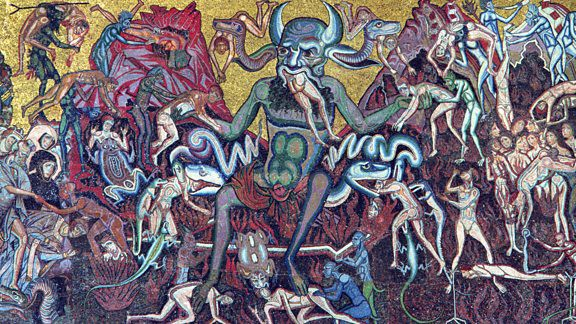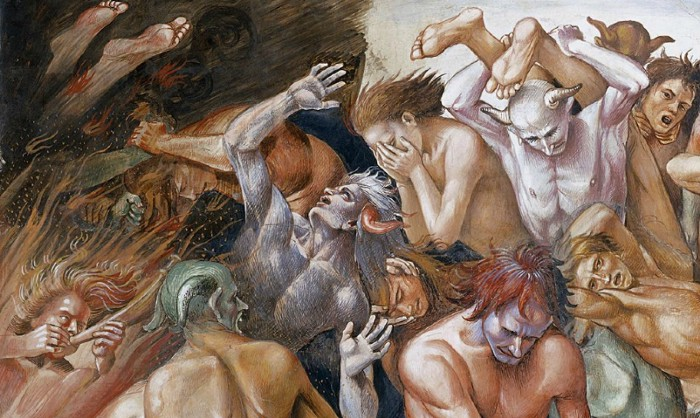Another green Devil in this illustration from a stained-glass window (I don’t know who painted it; it doesn’t say) showing him tempting Jesus in the desert. It’s, to be fair, a little simplistic: Satan is offering Jesus food and the Saviour is raising his hands as if to say “thanks dude but I just ate.” The Devil himself is almost a cartoonish figure here, indeed he is grinning, or seems to be. It would be next to impossible to fear this manifestation of the Devil, but it is interesting that, though his entire body is green, his head is yellow, while two blue snakes sprout from his head, almost, you might think, in a look back to the Gorgon Medusa, out of Greek legend, who could petrify a man with one glare. I expect though the snakes are meant to represent the one in the Garden of Eden, given that this is essentially a painting depicting temptation and resistance.
The feet are kind of clawed but also the heels reach back behind the legs, to make it look as if Satan is wearing some sort of pointy flippers or something, and I don’t know if that blue thing roughly positioned at his arse is meant to be a tail, but it looks like he’s farting a blue cloud! I think it’s just another element of the window that he happens to be painted against though. The face is mostly human, though with a sort of curving nose almost like that of a beak, and the artist has definitely attempted to make it look cruel, though I think it actually looks quite bland. But what do I know? I couldn’t even paint a stick man on a stained-glass window. Perhaps quite fitting, and probably intentional, that the background behind Satan is a lurid ruby red, while Jesus chills against a soft blue backdrop. Again though, the colours reverse compared to those used in that sixth century you-take-the-goats-I’ll-have-the-sheep mosaic.

One of perhaps the earliest of these comes from 1260, painted by a Florentine artist called Coppo di Marcovaldo. Okay, another source says it’s by a Franciscan monk called Jacobus. Whoever painted it, it’s a mural - seems to be part of a much bigger one that covers the ceiling of the Florence Baptistry - depicting the Last Judgement, and you can see by just looking at it that this was a painting created long before the traditional figure of the Devil was conceived and agreed on. Devils, or if you prefer, demons, were painted in many different colours by artists up to about the Renaissance, when the idea of a red-skinned demon took hold. Here, the devil is blue, and to be fair, bears little to no resemblance to what we recognise today as the image of Satan. There are horns, yes, and the feet could be cloven (though only one is visible, the other obscured by a corpse) but otherwise there are none of the usual features: no forked beard, no wings, no claws or talons, no scales. A Devil, as it were, shown as a work in progress.

Another Last Judgement (popular theme with artists painting the Devil, for obvious reasons) comes from the fifteenth century, painted by Fra Angelico, an Italian artist who built on the work of Jacobus or di Marcovaldo, whichever painted the one above, keeping his Devil blue, though this one is stockier, more almost gorilla-looking, with powerful muscular arms and a head looking more like the sort of thing that would begin to be seen on the shoulders of demons and the Devil later on. In contrast to the other one, Angelico’s devil seems to be covered with some sort of thick fur, and his eyes glow with a hellish yellow light. He too has horns, though considerably smaller than the earlier one (size isn’t everything you know!) and yes, like his contemporary he’s chowing down on humans, presumably damned ones. One thing that seems to be consistent with images of the Devil at this time is his hunger for human bodies. Wonder if he ever thought of just ordering from Deliveroo or Uber-Eats? Probably not.
There are other differences too. While Jacobus/di Marcovaldo’s devil is sitting on, well, something - kind of looks like he fell arse-first into the middle of a pizza, splitting it down the middle, Angelico’s one is enjoying a soak in the tub. Well, he’s in some sort of massive bowl in which I can only assume there is boiling water, or, well, something, with lots of lovely tasty humans, some possibly in parts, bobbing around in it. His lieutenant demons, unlike their master, are green and brown, that is, some are green and some are brown. I guess if you wanted to scare the faithful, this image is a pretty good attempt at it.

Until the advent of more permissive literature, I guess you might say, the Devil is seldom seen out of Hell. Almost all - perhaps all - of the paintings created up to at least the seventeenth century depict not himself, but Hell; he is seen as ruling there, often the central figure of course, but the main theme of these paintings is Hell and the punishment that awaits sinners in the afterlife. In the one above, painted just at the turn of the sixteenth century by Lucas Signorelli, there are demons - and the damned of course - but so far as I can see, no devil, no big boss, nobody overseeing things. The demons are again green and blue, and while there are flying ones hovering above in armour, I don’t think any of them are meant to represent Satan. Again, this is more for illustrating the horrors of going against the teachings of the Church, a preview of how your immortal soul could suffer eternal torment if you don’t buckle down and do as the priests say. It’s not a real attempt to depict the Devil; he’s pretty incidental here, though a looming, if unseen, presence. Perhaps he doesn’t need to be shown: at this point, everyone knows who runs things in Hell.